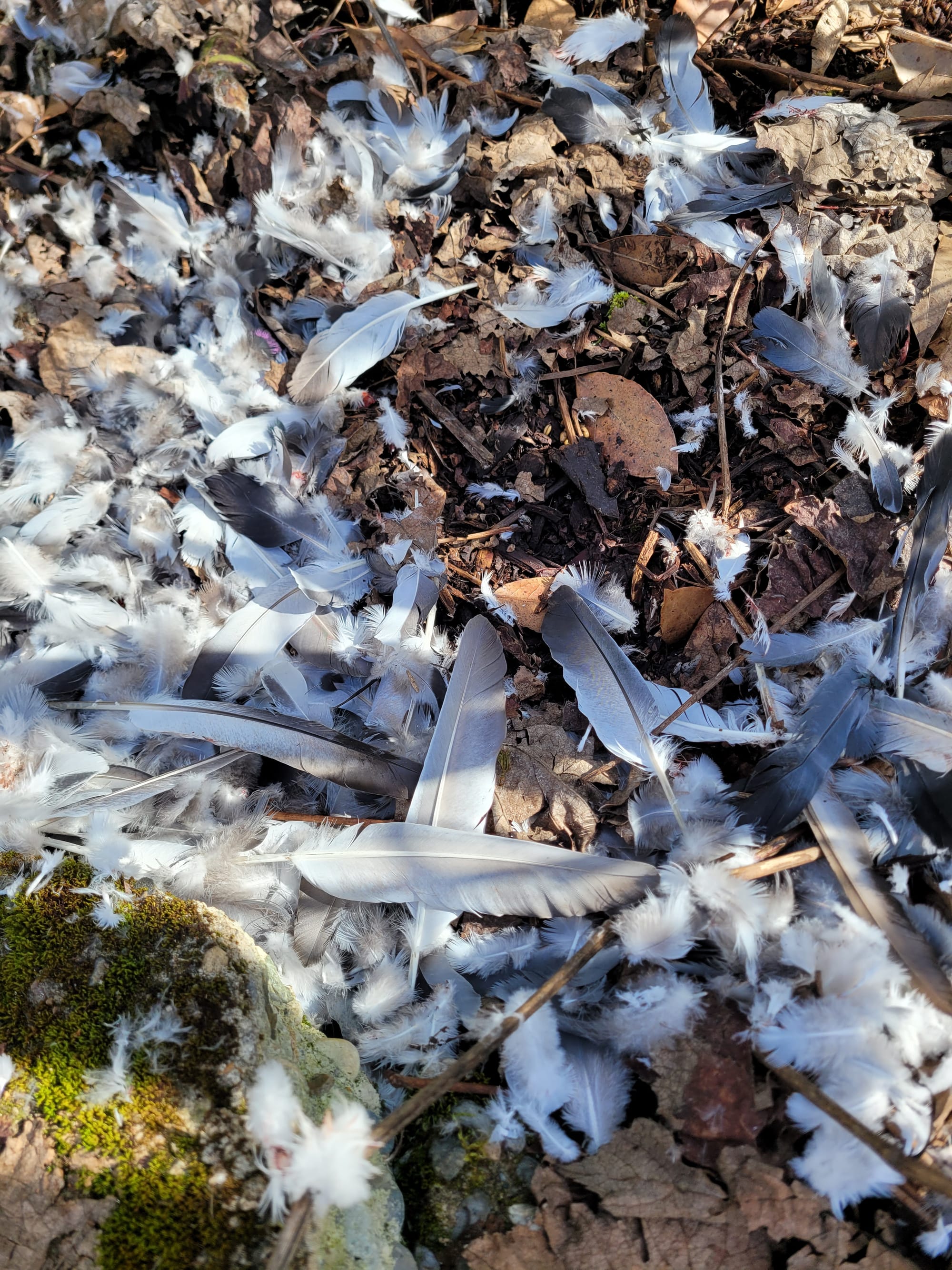Feathers

This is the third circle of white feathers to appear in our yard this year.
The first two were under the plum tree, between the front porch and the sidewalk. The white feathers fluffed against the dark, half-decomposed mulch surrounding the dormant blackberries and spirea. It’s the Pacific Northwest, when everything is dark and damp and the only colors are gray and brown. Dark gray and dark brown. A ring of white fluffy feathers is notable, and there were two.
Of course I investigated. I leaned in close and examined the feathers, white with shades of gray deepening to black along one of the edges. Some were puffy little pinfeathers, the kind that bring to mind the word loft. Many were long, smooth feathers, nearly six inches. These were flying feathers from the tips of the wings and the tail. They seemed like seagull feathers, but what do I know about seagulls? I know they are annoying, and so I never bothered to learn anything about them.
However, I was very interested to learn what might have created these circles of white feathers, because it clearly was not spontaneous seagull combustion.
In the center of each circle was a clue: a pile of seeds surrounded by something dark and sticky. Not blood, not guts, but gross. I was looking for something big enough to attack seagulls that had wandered an hour’s drive inland from the Pacific Ocean and that left behind a pile of … something.
This led me to owls, who, I learned leave behind what are called pellets of undigested parts of their prey. We had barred owls in our neighborhood, I knew, because I had seen them. Our first winter with Mabel, our thirty-pound border collie mix, she seemed so small. Our previous dog had been a sixty-pound dog that looked like a dingo, golden and pointy-eared, with someone else’s black tail tacked on. Mabel, in comparison, was tiny. One night, I let her out into the backyard before bed. While she was nosing around for an appropriate place in our muddy yard, I happened to look into the bare branches of a cherry tree. A massive barred owl was sitting there and staring at me in the yellowish glow of the outdoor lamp.
I may not have learned anything about seagulls, but I did learn about barred owls, and they are not great. They’re invasive to this region, but what are you going to do. But they’re also very aggressive. I had gone on a barred-owl fact-finding mission after visiting a trail across the river from my house where signs were posted warning hikers of barred owl attacks. They were dive bombing hikers with intent to harm. And I had just released my new (though entirely adult) tiny (though actually thirty pounds) dog into this creature’s killing field (my back yard). I called Mabel in while keeping my eyes on the owl, who kept her eyes on me. The oblivious dog trotted up the stairs and into the house. I closed the door and watched the owl for minutes. I looked away when my cat jumped onto a shelf next to me, and when I looked back at the cherry tree, its bare branches were empty.
So a barred owl was my first choice as seagull assassin.
Since I had settled on an owl, I was excited to buy some field cameras, the kind that researchers and hunters use to keep eyes on the animals that frequent a particular area. I have an acquaintance in the neighborhood, Tom, an older man who’s lived here all his life and still hunts in the woods across the river on private land. He has camera traps, so he must know where to get them and which ones to buy. I knew I’d end up with hours of nothing punctuated by the skunks, raccoons, and possums I know use my front yard as a highway after dark, but what if just once I caught an owl taking down a seagull in flight.
Meeting up with Tom is hit or miss. He’s a retired shop teacher, but he’s got a boat to get on the lake and hunting to do. I usually see him while I’m walking my dog, either in front of his house tending to his prize-winning roses or dutifully trudging around the neighborhood with a weighted pack in preparation for hiking the hills. I went weeks without seeing him, but his roses were cut back for the winter and his truck was sparkling clean, so I knew he was doing okay.
We live in a metro area with more than a million people. It’s known for voting solidly blue, though like any metro area there are more opinions than an electoral map would show. Tom and I have had civil sidewalk discussions about trans rights, on which we do not agree, and we have talked about the need for more vocational education, on which we do agree. Once he demonstrated his elk call, which he kept tied to one of his pack straps, on the street. It was incredibly loud. For a long time, years ago, before we began chatting in our neighborly way, Tom flew an NRA flag in front of his house. After the Newtown shooting, the flag disappeared and it has never come back out. I’ve never asked him about it.
I grew up in a very rural area. My dad was a hunter, and we, like many families in the county, often ate the venison from one deer over an entire winter. Some years, our Thanksgiving turkey was one my dad brought home from the woods. I am less squeamish about hunting than almost anyone I know. And I know that hunters know a lot about the local fauna. And they know a lot about camera traps.
But before I could even ask Tom about cameras let alone buy any and set them up, I got my answer, and it was not a barred owl. It was much better.
Just last week I was taking advantage of false spring to clean up the yard on a warm, sunny day. I was tromping around in my knee-high rubber boots a little after noon while the dog alternated between bringing me a ball and collapsing in a sunbeam. We have a small wood pile next to the garage, but we got rid of the fire bowl a couple of years ago when our city began a campaign to reduce pollution from smoke. Not to mention there have been hellacious wildfires in our state. It seemed wise to let the luxury of a little back yard fire go. This mean the wood pile sat unused and unmoved, a perfect habitat for who knows how many or what kind of animals. Actually, it’s rats. I do know what kind of animals. So I’ve been slowly depleting the woodpile by using some of the wood in our landscaping and putting the rest in the compost bin. (That’s the kind of liberal city I live in: composting at the curb.)
I picked up an armload of wood and headed for the green bin which sits under an overgrown grapevine that we don’t really know how to care for. Its vines are thick and woody and, for now, bare.
That’s when the magic happened.
As I stepped up to the bin, an explosion of white fluffy feathers lifted from the ground beneath the grapevine, about six feet away. A brown body at the center of the downy cloud flapped its wings and was out of sight.
Daytime. Not an owl. A seagull, so a large predator. A peregrine falcon.
This was thrilling.
I have seen peregrines in our neighborhood too. While walking the dog last fall, we saw one soar from a Douglas fir in a wooded park to snatch a small bird out of the air. On another walk, a peregrine sat on a low branch of a tree as we approached and let us just stare at it for a bit before realizing we were boring and slow, and so it took off. We also have merlins, which are smaller raptors with a better name. But they can’t take out a seagull. A peregrine falcon very much can. And apparently had, in front of my house, three times this year.
When I came out of my raptor-induced daze, I sprinted to the sidewalk and looked in the direction it had flown. There was not a feather to be seen.
Fauna in urban areas tend to do disappearing acts—now you see them, now you don’t. Once I saw a coyote climbing a six-foot chain-link fence that itself rested on top of a four-foot retaining wall made of decorative concrete bricks. I was with my large, dingo-like dog that time, and the coyote saw us. He stopped mid-ascent, and I stopped mid-sidewalk. He climbed back down and scampered around the corner. I had no interest in my dog fighting (or even befriending) a coyote, so I didn’t run around the corner, but it was only a few yards away. By the time we got there, he was gone in the muddy mist of winter. Those chickens never thanked me.
I again investigated the circle of white feathers next to the compost bin. This time I took pictures. There was a little pile of seeds, but I realized it was not the owl pellet I’d read about before. This was the contents of the seagull’s stomach, which the peregrine had no interest in eating, just as it had no interest in the feathers. It knew what it needed and it knew how to get it. It did not accept non-nourishing material, and it did not need me watching it strip its meal under the grapevine. And like that, he’s gone.

KHG’s latest translations, Memoirs of a French Courtesan Volume 1: Rebellion and Volume 2: Spectacle are available now. Volume 3: Luck coming May 2025!
